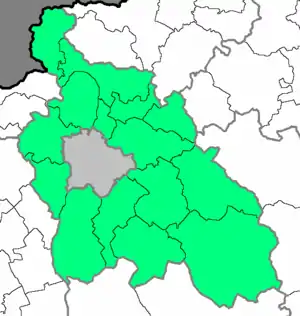Budapest Metropolitan Area
| |
|---|---|
 Map of Pest County | |
| Country | |
| Region | Central Hungary |
| Largest city | Budapest (1,757,618 pop. in 2015[1]) |
| Area | |
| • Metro | 7,626 km2 (2,944 sq mi) |
| Population | |
| • Metro | 3,303,786 |
| • Metro density | 431.1/km2 (1,117/sq mi) |
| GDP | |
| • Metro | €73.5 billion (2021) |
| Time zone | UTC+1 (CET) |
The Budapest metropolitan area (Hungarian: budapesti agglomeráció) is a statistical area that describes the reach of commuter movement to and from Budapest and its surrounding suburbs. Created by Hungary's national statistical office HCSO to describe suburban development around centres of urban growth, the surrounding a more densely built and densely populated urban area. As of 2014 the Budapest metropolitan area, with its 7,626 km² (2,944 sq mi), extends significantly beyond Budapest's administrative region (encompasses 193 settlements around the city), a region also commonly referred to as Central Hungary.[5] It had a population of 3,303,786 inhabitants at the January 2013 census, making it the tenth largest urban region in Europe (Larger urban zones in Europe).[6] 33% of Hungary's population resides in the region.
Economy
In 2021 Budapest's gross metropolitan product was €73.5 billion. This puts Budapest in 32nd place among cities in European Union.[7]
Traffic


There are 4 subway lines, 36 tram lines, 18 suburban railway lines (operated by MÁV-Hungarian State Railways and BKV-Public Transport Company of Budapest also) and 601 bus lines in the metropolitan area (2006).
Arterial motorways that also connects Budapest Metropolitan Area to the city center are M1 motorway (Hungary) from north-west, M2 motorway (Hungary) from north, M3 motorway (Hungary) from north-east with M31 motorway (Hungary) link, M4 motorway (Hungary) from east, M5 motorway (Hungary) from south-east with M51 motorway (Hungary) link, M6 motorway (Hungary) from south, M7 motorway (Hungary) from south-west.
M0 motorway (Hungary) ring-road of Budapest connects all arterial motorways.
Settlements of the Budapest metropolitan area
References
- ↑ "Population by type of settlement - annually". Hungarian Central Statistical Office. 11 Sep 2014. Retrieved 11 Sep 2014.
- ↑ "Budapest City Review". Euromonitor International. December 2012. Retrieved 8 May 2014.
- ↑ "Members of EMTA". European Metropolitan Transport Authorities (EMTA). August 2013. Retrieved 8 May 2014.
- ↑ "EU regions by GDP, Eurostat". www.ec.europa.eu. Retrieved 18 September 2023.
- ↑ History of the Budapest Commuter Association (English) Archived October 14, 2008, at the Wayback Machine
- ↑ "Gazetteer of Hungary, Hungarian Central Statistical Office, 2014" (PDF). Retrieved 3 April 2015.
- ↑ "EU regions by GDP, Eurostat".